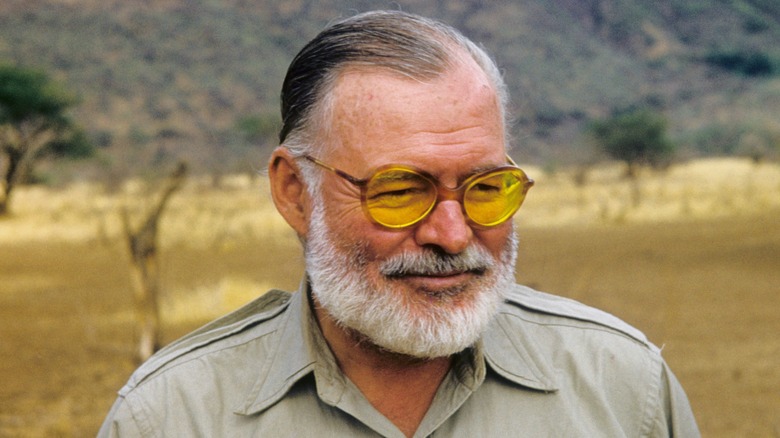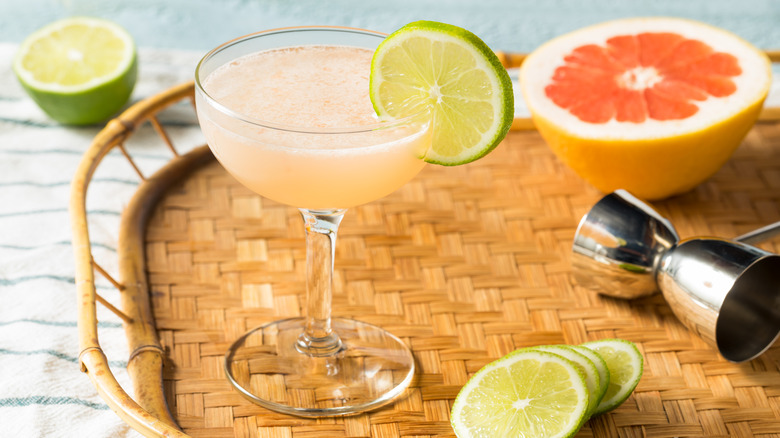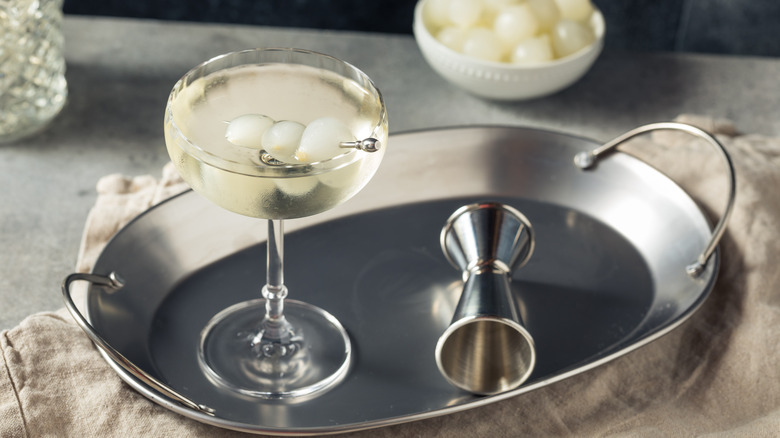Ernest Hemingway's Favorite Cocktail Was A Rum Classic
We may receive a commission on purchases made from links.
Ernest Hemingway was known for a love affair with Cuba, fishing and boating, big game hunting, bullfight watching, and, of course, a number of iconic works of literature. The man also loved a cocktail, especially an iconic Cuban one: the daiquiri. Hemingway's favorite drink was a simple, sweet-tart drink usually made with light rum, sugar, and freshly squeezed lime juice.
He was a fan of the daiquiris from El Floridita in Havana, and he particularly liked how bartender Constantino "Constante" Ribalaigua mixed them up. He waxed poetic, saying that drinking one of his famed daiquiris felt "the way downhill glacier skiing feels running through powder snow" (per Difford's Guide). Havana's premiere bartender Ribalaigua riffed on many known cocktails and invented an estimated 200 more, including Hemingway's very own signature drink — a take on the daiquiri sans sugar. Though Ribalaigua did not invent the daiquiri, he certainly receives well-deserved credit for making it what it is.
An American engineer living in Cuba named Jennings Cox is the drink's actual creator, and he named it for the town of Daiquiri, Cuba, where many expatriates worked. Due to the straightforward and widely available ingredients, chances are that several versions of this drink already existed, but Cox was the first to actually write down a recipe in 1896.
How did Ernest Hemingway take his daiquiri?
Typically, a daiquiri includes two parts white rum, one part lime juice, and ½ to ¾ of an ounce of simple syrup. Ernest Hemingway tried it but wanted something less sweet and more boozy for the next round. The legend goes that Constantino Ribalaigua made a version of the daiquiri with twice as much rum and no sugar.
This drink is very boozy, acutely sour, and a little lacking in both flavor and texture. However, Hemingway's questionable preferences gave way to a better rendition now known as a Hemingway Daiquiri or a Papa Doble. Antonio Meilan — who became the head bartender at El Floridita after Ribalaigua — is credited with the additions of grapefruit juice and maraschino liqueur to the stout combination of straight-up rum and lime juice.
Ribalaigua also was known for using ice chips rather than whole cubes when shaking his daiquiris, which was an innovation at the time. It led to a frothy texture with fine shards of ice ending up in the final drink. Eventually, they doubled down on that concept at El Floridita, and blended daiquiris became the go-to there. These days, when you order a Hemingway Daiquiri sometimes sugar or simple syrup is added, but for the sharper, more acidic taste that Hemingway preferred, the drink combines just white rum, lime juice, grapefruit juice, and a touch of maraschino liqueur. It can be served shaken and strained into a coupe glass or blended.
What other cocktails did Ernest Hemingway enjoy?
Ernest Hemingway's drinking habits were as legendary as his writing — the famous author had a penchant for imbibing significant quantities of alcohol. The daiquiri was certainly not the only beverage that he had a thing for — he also liked a bloody mary, red wine, whiskey sodas, gimlets, gin and Calvados, and more. Though quantity was a factor, he also always valued a well-made drink that used high-quality ingredients.
Hemingway is also closely associated with another bespoke cocktail — the Death in the Afternoon. It appears that Hemingway actually crafted this strongly-made drink himself. A Death in the Afternoon just combines one part absinthe with three parts ice-cold Champagne, and it sometimes has simple syrup as well. Absinthe brings notes of wormwood, fennel, and anise to the party — while the sparkling wine keeps it dry and crisp. The high-proof liquor also is somewhat viscous, so it creates a more velvety texture when combined with the Champagne.
Hemingway also liked to take a martini dry ... very dry, in fact. His preferred ratio was 15 to one of gin to vermouth, which is known as a Montgomery's dry martini. In an iconic scene, a character in Hemingway's novel "Across the River and Into the Trees" orders them at one of the author's real-life Venice, Italy haunts: Harry's Bar. Hemingway's garnish of choice? A frozen pearl onion, which actually makes this beverage more like a Gibson cocktail.



